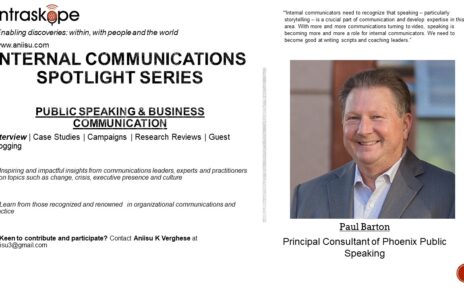As the cab driver worked his way through Ahmedabad’s traffic he shared how he built a special rapport with management professors who visited the well-known Indian Institute of Management (IIM) in the city. They counted on him to be shown around the heritage city and beyond because of his responsiveness (always a call away), reliability (professors often fell asleep on long journeys and yet knew they were in safe hands) and relevance (knew the landscape and tourist spots well) as a local. His reputation stood in good stead and he explained that they only preferred to travel with him whenever they visit the city. He built his reputation over time, consistently keeping in touch with his clients and improving their experiences each time they met.
On a similar line, I had the opportunity to interact with a group of IIM students recently and discuss approaches to manage and communicate corporate reputations. My message focused on how behavior, performance, and communication combined with authenticity could essentially change how stakeholders perceived the brand. That is, reputations are best managed inside-out and is mostly about culture change.
Very often when organizations and individuals lose the plot with reputation, the initial reaction is to deny and defend current practices or put the blame on other protagonists and actions. With reputation defined as the sum of the images that various stakeholders have of an organization, people entrusted with the role of maintaining and restoring company reputation look outside to minimize the damage. That approach comes across as stop-gap and unauthentic. Today, purchase decisions and advocacy by stakeholdersare linked to how organizations’ reputations are viewed. Products and services and emotional appeal are among the top two dimensions that impact reputation. Likewise, the most toxic element is lying or misrepresenting facts and can severely damage a corporate reputation.
There is good news – it is possible to review and restore lost reputations. Bringing about a reputation revival from within can be long lasting and sincere. It is, however, harder than it looks. Can organizations turn around their reputational fortunes hinging a lot on internal communication? Here are approaches that can potentially lead to restored or improved corporate reputations.
· Facing the issue head-on: Unlike a crisis scenario, a reputation issue expects organizations to take stock and be honest in their assessment. Stating facts, indicating a willingness to go deeper into the issue, addressing work ethos concerns and make a commitment to take corrective action are what stakeholders, especially employees, expect in the short-term. If the issue stems from a deliberate act of misrepresentation, there is more reason to be open to scrutiny. When the issue is more systemic, deep reflection can help organization’s recover swiftly. It does take courage and awareness to tackle a reputational crisis. Getting your employees on your side is essential.
· Taking employees along: In today’s hyper-connected world, no internal communication can be safeguarded to stay within the organization. Sooner or later it will find its way in the public domain. Think of anonymous review sites and you know what I am saying. Leadership messages, manager conversations, offer letters, bonuses provided – you name a document that is classified as ‘internal’ or ‘confidential’ and if you Google it up, chances are that you can find them online! Therefore, getting your employees to trust what you do and hear first any news that impacts them – before the world gets wind, is a healthy practice. Treating employees like adults is an effective approach while communicating changes that involve their welfare. Which also means anchoring the change with a purpose.
· Revitalizing the purpose: Going to the core of the issue will mean revisiting what the organization stands for and how far away has it drifted. It can also mean rearticulating the values and purpose again. Setting expectations about the journey and the trials and tribulations that can occur are helpful early in the engagement. Likewise, linking actions taken with the values of the organization is a powerful way to anchor people to the core focus. When leaders communicate often and directly, employees trust their decisions better. Decisiveness is, therefore, a game-changer.
· Making inclusive leadership decisions: When reputations are at stake, stakeholders look to leaders to make decisions, albeit with a large degree of empathy and a great deal of openness. It is easy to remove staff and hive off non-performing business units to steer the organization in a different direction but the scars of such actions can be long lasting. Stakeholders expect leaders to ‘behave’ rather than ‘talk’ and do so empathetically. However, reputation isn’t just about the leader. Stakeholders believe it more when they experience each and every employee living the same values. Research scholars have represented reputation as a formula with factors such as performance, behavior, communication, and authenticity adding up. Authenticity is critical in gaining trust on other factors in the mix. Stakeholders can read through any actions that are superficial and dubious. Transparent communication is the bedrock of reputation management.
· Communicating consistently: Companies with high reputational scores are known to communicate more often with stakeholders than those with lesser ranking on the index. Communication isn’t restricted to leadership messages for employees. It is about sharing openly and transparently at all levels and with a range of stakeholders. For example, the choice of words in an employment form, the tone of voice in a poster on a notice board or the accessibility of channels for different audiences adds up for communication to be perceived as consistent and honest. Likewise, providing stakeholders the platform to share stories of their relationships with the organization can be a powerful dialogue. The atmosphere of the workplace can also influence your corporate reputation.
· Improving the workplace experience: The people you work with, the workplace environment, the facilities you have access to or the experience you get when you interact with colleagues can make or mar a reputation. If you feel uncomfortable challenging the status quo or reaching out to a leader or your manager for a conversation, there is something amiss about the culture and therefore the reputation. It isn’t about productivity at work but the faith you have in the organization and its ability to stand up for people. Respect, humility, and relationships are crucial for workplaces to prosper, leading to reputation improvements. Treating the community fairly and giving more than you take from society can further reputational clout.
· Committing as a corporate citizen: In a crisis or otherwise, how the organization behaves with the communities it serves also matters for reputation. By listening intently to the needs, taking feedback constructively and applying insights for stakeholders’ benefits, it can lead to improved reputational perception. From the content on the intranet or the website, the dialogue which the organization champions for the wider good of society or the policies that protect and promote the community are valued by stakeholders. Your employees need to be the ambassadors of this change effort for stakeholders to see merit and value contribution.
Building or restoring your reputation is more authentic when practiced from within. Any other way can be perceived as insincere leading to mistrust and resentment among stakeholders.



